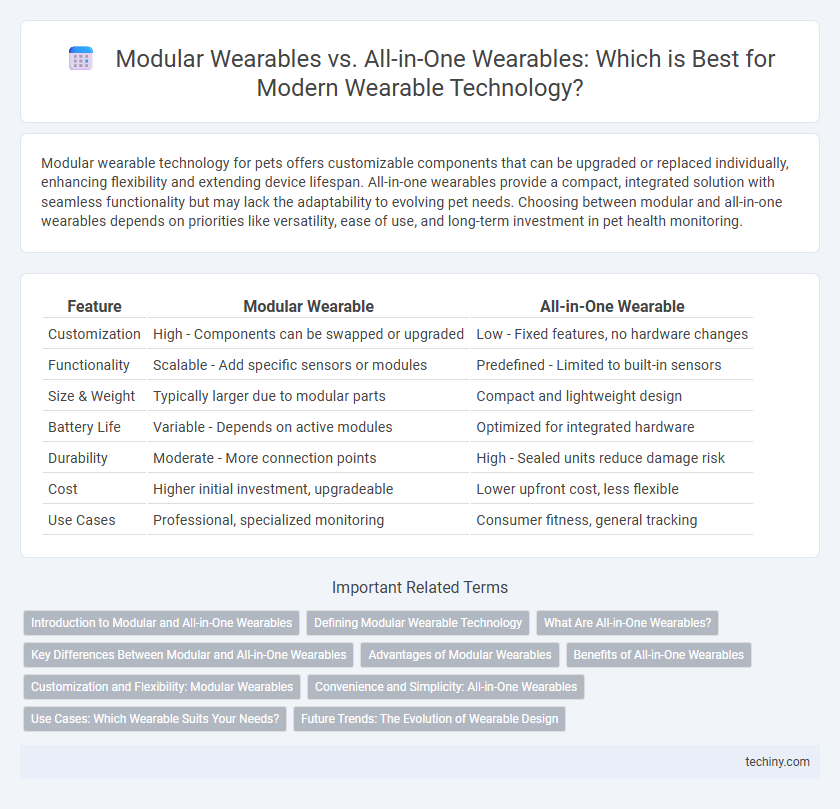Modular wearable technology for pets offers customizable components that can be upgraded or replaced individually, enhancing flexibility and extending device lifespan. All-in-one wearables provide a compact, integrated solution with seamless functionality but may lack the adaptability to evolving pet needs. Choosing between modular and all-in-one wearables depends on priorities like versatility, ease of use, and long-term investment in pet health monitoring.
Table of Comparison
| Feature | Modular Wearable | All-in-One Wearable |
|---|---|---|
| Customization | High - Components can be swapped or upgraded | Low - Fixed features, no hardware changes |
| Functionality | Scalable - Add specific sensors or modules | Predefined - Limited to built-in sensors |
| Size & Weight | Typically larger due to modular parts | Compact and lightweight design |
| Battery Life | Variable - Depends on active modules | Optimized for integrated hardware |
| Durability | Moderate - More connection points | High - Sealed units reduce damage risk |
| Cost | Higher initial investment, upgradeable | Lower upfront cost, less flexible |
| Use Cases | Professional, specialized monitoring | Consumer fitness, general tracking |
Introduction to Modular and All-in-One Wearables
Modular wearables consist of interchangeable components that allow users to customize and upgrade specific features such as sensors, batteries, or communication modules, enhancing flexibility and personalization. All-in-one wearables integrate all essential functions into a single compact device, offering streamlined usability and consistent performance without the need for additional attachments. Both approaches address different user needs, with modular designs prioritizing adaptability and all-in-one models emphasizing simplicity and convenience.
Defining Modular Wearable Technology
Modular wearable technology consists of individual, interchangeable components that users can customize and upgrade independently to enhance functionality and personalize their experience. This approach contrasts with all-in-one wearables, which integrate all features into a single, sealed device, limiting flexibility but offering streamlined design and immediate usability. Modular wearables improve adaptability and extend device lifespan by allowing targeted hardware or software enhancements without replacing the entire system.
What Are All-in-One Wearables?
All-in-one wearables integrate multiple sensors and functionalities into a single device, offering seamless user experience without the need for additional attachments. These devices typically combine fitness tracking, heart rate monitoring, GPS, and smartphone notifications, making them convenient for everyday use. Their compact design prioritizes ease of use and portability while maintaining comprehensive health and activity monitoring.
Key Differences Between Modular and All-in-One Wearables
Modular wearables feature interchangeable components, allowing users to customize sensors and functionalities such as heart rate monitors, GPS, or environmental sensors to fit specific needs, unlike all-in-one wearables that integrate fixed features in a single device. All-in-one wearables offer streamlined design and ease of use with pre-installed sensors and software optimized for general purposes like fitness tracking or notifications. The flexibility of modular wearables supports specialized applications in healthcare and industrial environments, while all-in-one devices prioritize convenience and immediate usability for everyday consumers.
Advantages of Modular Wearables
Modular wearables offer significant advantages in customization and upgradeability, allowing users to tailor functionality by adding or swapping components based on evolving needs. Enhanced sustainability is achieved by reducing electronic waste, as individual modules can be replaced or upgraded without discarding the entire device. This flexibility supports diverse applications across health monitoring, fitness tracking, and smart communication, making modular wearables a versatile choice compared to all-in-one devices.
Benefits of All-in-One Wearables
All-in-one wearables offer seamless integration of sensors and features, ensuring consistent performance and convenience for users. Their compact design enhances comfort and style, making them ideal for continuous use in various environments. Enhanced battery efficiency and streamlined software updates contribute to a reliable and user-friendly wearable experience.
Customization and Flexibility: Modular Wearables
Modular wearables offer unparalleled customization and flexibility by allowing users to mix and match components such as sensors, batteries, and display units according to their specific needs. This adaptability supports various use cases, from fitness tracking to health monitoring, enabling personalized functionality that all-in-one wearables often lack. The modular design also facilitates easy upgrades and repairs, extending device lifespan and reducing electronic waste.
Convenience and Simplicity: All-in-One Wearables
All-in-one wearables offer unmatched convenience and simplicity by integrating multiple functions into a single compact device, eliminating the need for multiple accessories. Users benefit from streamlined design and straightforward operation, making these devices ideal for everyday use and seamless connectivity. The unified hardware and software ecosystem ensures effortless management and consistent performance without configuration complexities.
Use Cases: Which Wearable Suits Your Needs?
Modular wearable technology offers customizable components ideal for users needing specific functionalities, such as athletes requiring advanced health tracking and professionals benefiting from interchangeable sensors. All-in-one wearables deliver integrated solutions suited for general users prioritizing convenience and seamless user experiences like daily fitness monitoring and smartphone notifications. Analyzing use cases highlights that modular wearables excel in adaptability, while all-in-one devices provide simplicity and streamlined features.
Future Trends: The Evolution of Wearable Design
Modular wearable technology is rapidly advancing, enabling users to customize and upgrade individual components such as sensors, batteries, and displays, enhancing functionality and prolonging device lifespan. All-in-one wearables continue to emphasize sleek, integrated designs with improved biometric accuracy and seamless AI integration for real-time health monitoring and personalized feedback. Future trends indicate a convergence of these approaches, where modularity will blend with compact, all-in-one aesthetics to create adaptable, user-centric devices tailored for diverse lifestyle and medical applications.
Modular Wearable vs All-in-One Wearable Infographic

 techiny.com
techiny.com